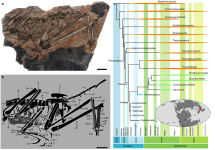Fred Ruhe
Well-known member

Liming Xu, Min Wanf, Runsheng Chen, Liping Dong, Min Lin, Xing Xu, Jianrong Tang Haiulu You. Guoqu Zhou, Linchang Wang, Wenxing He, Yujuab Li, Chi Zhang & Zhonghe Zhou, 2023
A new avialan theropod from an emerging Jurassic terrestrial fauna
Nature: 1–8. doi:10.1038/s41586-023-06513-7. ISSN 1476-4687.
Abstract
Birds are descended from non-avialan theropod dinosaurs of the Late Jurassic period, but the earliest phase of this evolutionary process remains unclear owing to the exceedingly sparse and spatio-temporally restricted fossil record1,2,3,4,5. Information about the early-diverging species along the avialan line is crucial to understand the evolution of the characteristic bird bauplan, and to reconcile phylogenetic controversies over the origin of birds3,4. Here we describe one of the stratigraphically youngest and geographically southernmost Jurassic avialans, Fujianvenator prodigiosus gen. et sp. nov., from the Tithonian age of China. This specimen exhibits an unusual set of morphological features that are shared with other stem avialans, troodontids and dromaeosaurids, showing the effects of evolutionary mosaicism in deep avialan phylogeny. F. prodigiosus is distinct from all other Mesozoic avialan and non-avialan theropods in having a particularly elongated hindlimb, suggestive of a terrestrial or wading lifestyle—in contrast with other early avialans, which exhibit morphological adaptations to arboreal or aerial environments. During our fieldwork in Zhenghe where F. prodigiosus was found, we discovered a diverse assemblage of vertebrates dominated by aquatic and semi-aquatic species, including teleosts, testudines and choristoderes. Using in situ radioisotopic dating and stratigraphic surveys, we were able to date the fossil-containing horizons in this locality—which we name the Zhenghe Fauna—to 148–150 million years ago. The diversity of the Zhenghe Fauna and its precise chronological framework will provide key insights into terrestrial ecosystems of the Late Jurassic.
Enjoy,
Fred
A new avialan theropod from an emerging Jurassic terrestrial fauna
Nature: 1–8. doi:10.1038/s41586-023-06513-7. ISSN 1476-4687.
Abstract
Birds are descended from non-avialan theropod dinosaurs of the Late Jurassic period, but the earliest phase of this evolutionary process remains unclear owing to the exceedingly sparse and spatio-temporally restricted fossil record1,2,3,4,5. Information about the early-diverging species along the avialan line is crucial to understand the evolution of the characteristic bird bauplan, and to reconcile phylogenetic controversies over the origin of birds3,4. Here we describe one of the stratigraphically youngest and geographically southernmost Jurassic avialans, Fujianvenator prodigiosus gen. et sp. nov., from the Tithonian age of China. This specimen exhibits an unusual set of morphological features that are shared with other stem avialans, troodontids and dromaeosaurids, showing the effects of evolutionary mosaicism in deep avialan phylogeny. F. prodigiosus is distinct from all other Mesozoic avialan and non-avialan theropods in having a particularly elongated hindlimb, suggestive of a terrestrial or wading lifestyle—in contrast with other early avialans, which exhibit morphological adaptations to arboreal or aerial environments. During our fieldwork in Zhenghe where F. prodigiosus was found, we discovered a diverse assemblage of vertebrates dominated by aquatic and semi-aquatic species, including teleosts, testudines and choristoderes. Using in situ radioisotopic dating and stratigraphic surveys, we were able to date the fossil-containing horizons in this locality—which we name the Zhenghe Fauna—to 148–150 million years ago. The diversity of the Zhenghe Fauna and its precise chronological framework will provide key insights into terrestrial ecosystems of the Late Jurassic.
Enjoy,
Fred





